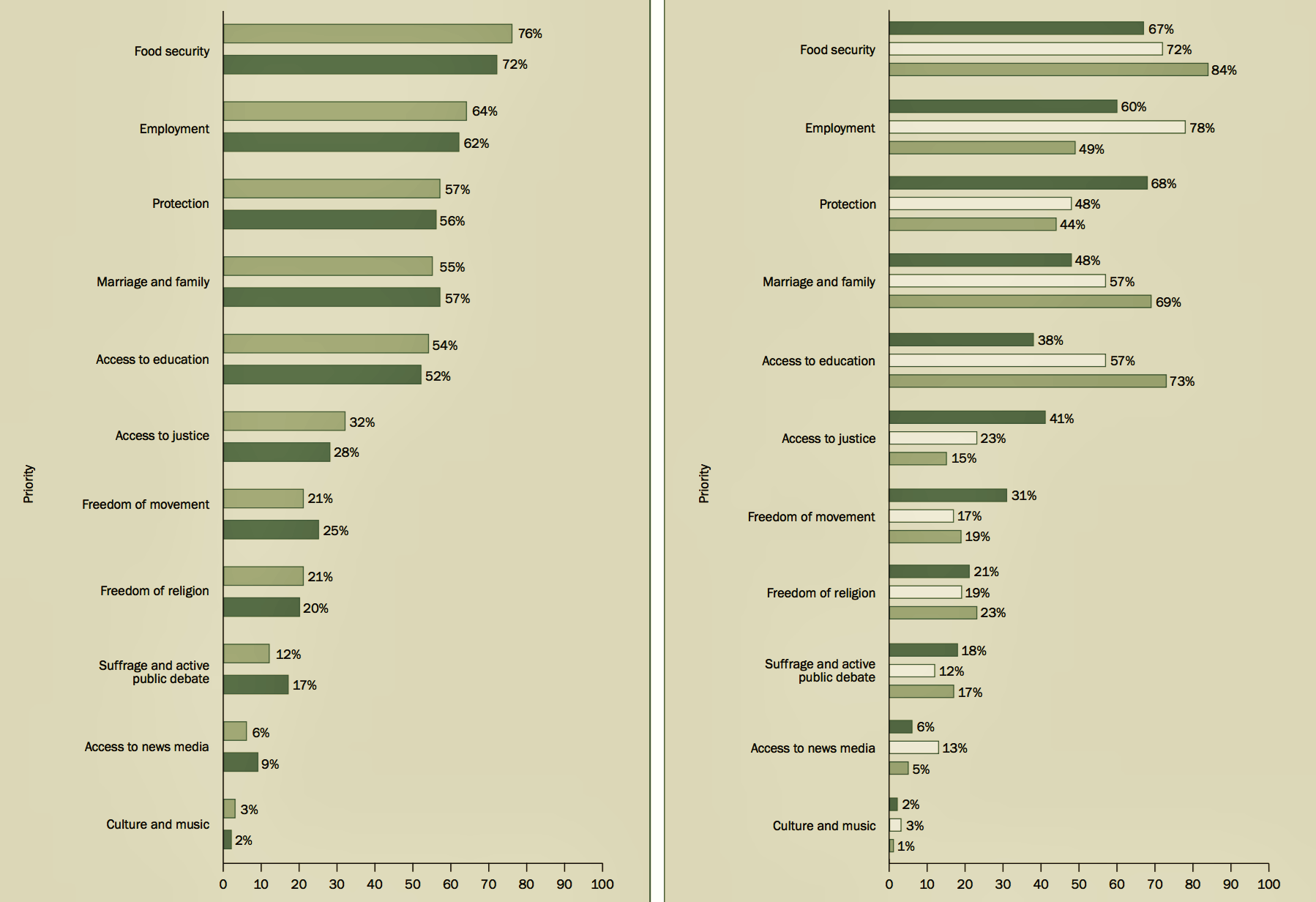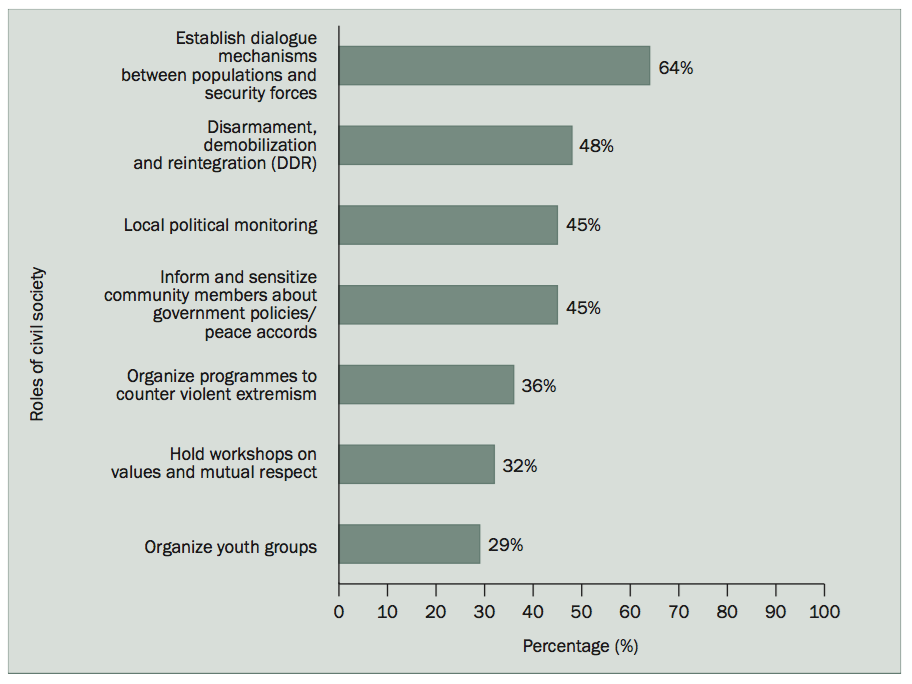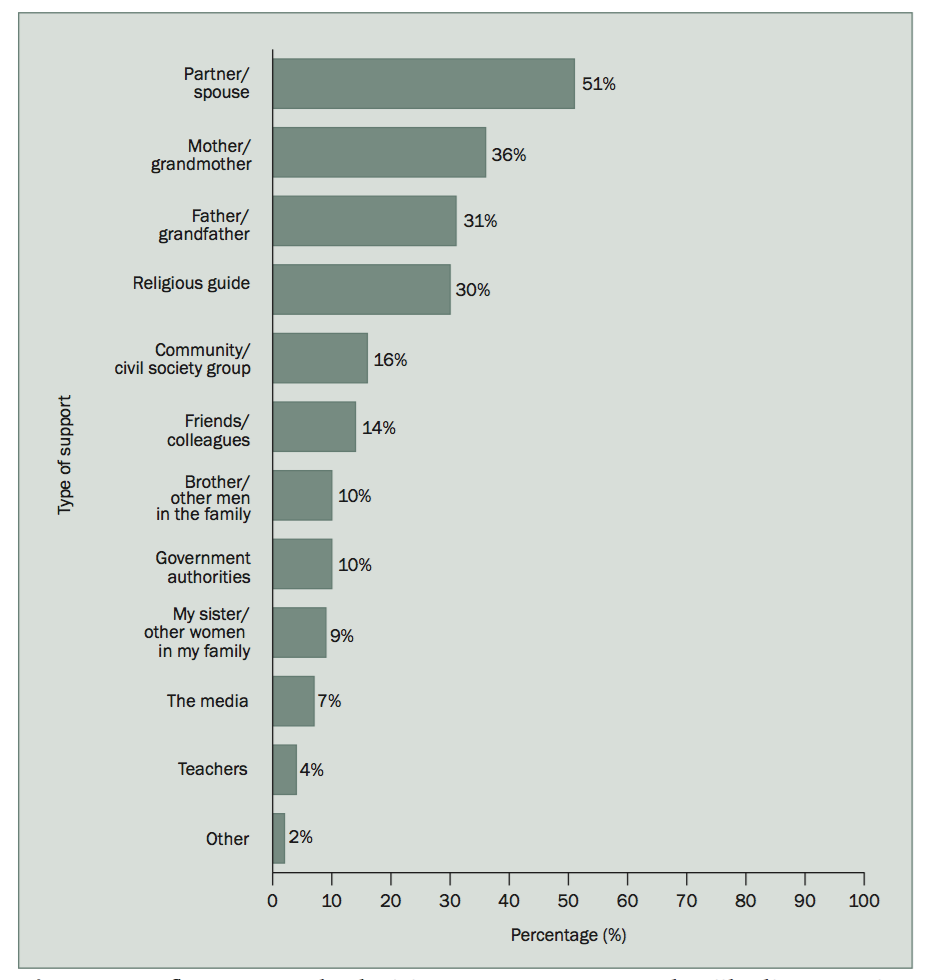Women in Mali: Key influencers in turning the tide
As conflict ripples through northern and central Mali, new research reveals women could play monumental roles in steering the country towards war or peace.
A study I undertook with the Stockholm International Peace Research Institute (SIPRI) reveals key ways women influence peacebuilding. The findings draw on a survey questionnaire distributed across the country’s ten regions to women and men, focus group discussions among women in 36 localities and three qualitative studies in the regions of Mopti, Ségou and Gao.
Conducted in partnership with the Malian civil society organisation CONASCIPAL, the study looks at the intersection of gender and conflict at the local, national and international levels through four lenses: observers, victims, actors and agents of change.[1] As women play valuable roles in the evolving conflict, Mali’s peace process also presents a unique opportunity to shift societal status quos in favor of greater inclusivity for Malian women. Both might prove essential for lasting stability in the Sahel.
| Research Lens | Key Findings |
| Observers | Women perceive insecurity in their communities in similar ways to men. Their opinions reflect, and could credibly represent, their broader communities in asserting local priorities and in assessing current and future responses to crisis across Mali’s highly variegated security landscape. |
| Victims | Most types of insecurity affect women and men in tantamount. Notable exceptions: sexual and gender-based violence and the erosion of economic and social capital. “These cases of gender based violence existed well before the crisis,” declared one woman from Gao. “But since 2012, they’ve become the norm. Nobody is spared. Even women in their 60s are violated.”[2] |
| Actors | Women function primarily as informants and other supporting roles within armed and jihadist groups, rather than as active combatants. Wives and mothers are among the most influential voices in decisions to join, leave or remain implicated in such groups. |
| Agents of Change | Women interviewed stressed a strong desire to become more involved in decision-making but cited significant obstacles and resistance. However, analysis indicates a window of opportunity to further women’s participation from both the top-down and bottom-up. |
The United Nations Security Council Resolution 1325 (2000) and the Women, Peace and Security (WPS) agenda have supported the idea that greater gender equality and meaningful participation in peacebuilding processes lead to longer-lasting peace.[3] Yet since its adoption in 2013, Mali’s National Action Plan for integrating UNSCR 1325, along with the 2015 Bamako Agreement, has gone mostly unimplemented.[4]
Violence continues to spread throughout the northern and central Mali. Peace negotiations are continuously critiqued for maintaining a status quo, rather than engaging new and diverse stakeholders.[5] Despite these shortcomings, the research findings reveal women could play key roles in turning the tide of conflict in both the public and private spheres.
Women as credible voices in observing the crisis
The study shows women form opinions about conflict very similar to men. Perceptions of fragility factors, assessments of current responses and opinions about helpful policies varied more by region and urban or rural environment than by identity-based factors of gender or age. Women’s voices were found to be representative of their broader communities on a wide range of issues.

Note: The graphs show responses to the question ‘What are your top four community priorities?’
Participants of both genders reported the security situation worsening over time with an attenuating confidence in exogenous security forces such as MINUSMA and the French Operation Barkhane, coupled with a cautiously positive view of the Malian army and national security forces.[6] The participants did not score any actor as significantly improving their sense of safety, implying both men and women perceive a critical security vacuum.
In answering what role civil society can play to best improve this security situation, men (62%) and women (72%) most commonly selected establishing dialogue mechanisms between populations and the security forces.[7] This strategy proved an important feature of the peace negotiations among Tuareg separatist movements in the 1990s. In the North, assisting with disarmament, demobilization and reintegration (DDR) initiatives also stood out as a top priority (65%), and in the Centre, informing communities on the peace accords and political processes (51%).

Notes: The graph shows responses to the question ‘What role should civil society play in improving the security situation?’ Respondents could select up to 3 options.
Key influencers and conflict engagement
The results indicate women can make significant contributions to peacebuilding efforts in Mali by influencing potential and current fighters. When asked to whom respondents would listen if deciding to join, leave or remain in an armed or jihadist group, spouses surfaced as the most commonly influential voices, while mothers ranked second, followed by fathers and religious guides.

Notes: The graph shows responses to the question ‘Which person had the most influence on your decision to support or not support a non-state armed group or jihadist group?’ Twelve options (including ‘Other’) were listed.
These findings reflect literature arguing for the need to recognize the intersection of public and private spheres, especially among societies for which the invisible control of women from within the household or clan can confer a certain status and position.[8]
According to respondents, women do not serve primarily as combatants, but as informants (56%),[9] providers of goods and supplies (38%), brides to combatants (34%), contributors of economic services (29%) and mobilisers encouraging family members to join (24%). Religion stood out as the primary motivating factor for women to support jihadist groups (50%), while physical protection and economic security were the primary drivers for supporting non-state armed groups and significant secondary or parallel motivators for jihadist recruitment.
Partners in Peace: Opportunities and challenges for women
Concerning the public sphere, women interviewed expressed determination to become involved in decision-making and peacebuilding, citing notable efforts in disarmament in the region of Gao. However, focus group participants also pointed out a number of obstacles: the refusal of men or traditional authorities to allow them to participate,[10] illiteracy, unwanted pregnancies, disputes amongst women themselves, domestic obligations, a general lack of information shared with them, and little of freedom of movement.
Participants from a focus group in Gao expressed hope in spite of these hurdles: “People generally see women as weak spirits. But the crisis has revealed that women are dynamic spirits and invaluable to their communities. One of our strategies as women is strong solidarity, which allows us to come together in associations to share ideas. [Women’s associations] intervened directly to negotiate peace between the belligerent groups of MUJAO [Movement for Oneness and Jihad in Africa] and the MNLA [National Movement for the Liberation of Azawad][11].”
Amidst economic devastation linked to insecurity and violence, women risk further loss of social capital if they venture into the public space and can be shamed for participating in politics. Women seeking political office continue to experience resistance to their candidacy and are rarely able to financially support their own campaigns, including paying to position themselves strategically on party lists.
Yet patterns of gender reform in Mali and prior research on post-conflict African states indicate that times of conflict and peacebuilding present a significant opportunity to alter the status quo of gender power relations at a national level (see the timeline below for examples from Malian history). Notable recent gains following the 2015 Bamako Agreement have provided legal measures for enacting a 30% quota for women in appointed governmental functions and on electoral lists and reserving access to 15% of governmental arable land for female farmers.
Timeline of notable initiatives by and for women in Mali
1945 March of women on Bamako prison to liberate director and editor of the journal L’Essor Mamadou Sangaré and Abdoulaye Singaré, demonstrating the capacity of illiterate women to participate in the public sphere.
1946 Colonial constitution gives Malians citizens’ rights under French Union, including suffrage for all women.
1951 Women’s network led by Aoua Keïta hand delivers voting cards taken from Sudanese civil servants; it also occupies voting sites to thwart electoral fraud and removes two military officers trying to force votes for the French party. The Jacquinot decree allows women of 21 years or older to freely choose husbands; and women liberated from obligations of dowry.
1959 Aoua Keïta elected to national assembly of Mali Federation as first female deputy.
1960 Mali gains independence from France.
1962 Women gain the right to consensual marriage: rape is made punishable by up to 20 years in prison; educational reform allows for mixed schools: and women create the Commission for Social Women in Mali.
1968 The first female minister is appointed to the government of Moussa Traoré.
1990-2 Women lead protest marches against Moussa Troaré in March 1991, form the Collective of Women in Mali (COFEM) and play key roles in initiating talks between government and Tuareg rebels, including mitigating a hostage situation in Kidal.
1996 Women in Timbuktu are instrumental in inaugurating ‘Flame of peace’ ceremony burning arms; becomes an annual protest of small arms and light weapons.
1997 Creation of the Ministry for the Promotion of Women, Children and Family (MPFEF).
2001 Women organise 15 of 50 inter-community meetings to repair social ties and implement long-term peace and reconciliation strategies.
2009–11 Proposed revisions to the Family Code that would have expanded women’s rights concerning the legal age for marriage, custody for children and inheritance are watered down amid religious protests.
2011 Cisse Mariam Kaidama Sidibe serves as the first female prime minister, and the first national policy on gender is adopted.
2013 Four women travel to Ouagadougou to demand a place in the peace process; adoption of first National Action Plan on UNSCR 1325.
2015 The Bamako Agreement is signed in June. In December, national law enacts a 30% quota for women in appointed governmental functions and on electoral lists.
Source: Author compilation
Moving forward, the unfolding peace efforts could be conducive to improving gender equality at the national level. The re-election of President Ibrahim Boubacar Keita in August 2018 might afford the president some political stability to counter the interests of an entrenched political and religious elite. The administration announced a new government in September 2018 with eleven female ministers out of 33 including the nation’s first female minister of foreign affairs, but in the latest government reshuffle, this was reduced to eight female ministers out of 36.[12]
In addition to expanding opportunities for women on the national stage, SIPRI’s findings emphasize the critical roles women can play at the grassroots level in influencing those around them and in putting forth perspectives. It is therefore essential to understand local community dynamics and to work together with women and men in improving outcomes for sustainable peace.
Footnotes:
[1] A quantitative survey was distributed to 387 respondents throughout Mali’s 10 regions in November 2017, with 36 homogenous focus groups among women conducted during the same period. The quantitative sample included 281 women, 102 men and four individuals who did not select a gender — 172 participants from the North zone (regions of Toaudéni, Kidal, Gao, Ménaka and Timbuku), 113 from the Cental zone (regions of Mopti and Ségou) and 101 participants from the South zone (regions of Sikasso, Kayes and Koulikoro and the District of Bamako). Qualitative reports on themes voted most important among a network of 36 women from each locality were produced in May 2018 using interviews conducted in Mopti, Ségou and Gao by Malian research teams. The findings were validated at a series of workshops held in Bamako from Jan 2018-July 2019 among the SIPRI-CONASCIPAL civil society network.
[2] ‘Ces cas de VBG existaient bien avant la crise. Mais depuis 2012, c’est même devenu une mode. Personne n’est épargné. Même les femmes de 60 ans ont été violées.’ Qualitative studies conducted by Malian researchers in SIPRI and CONASCIPAL’s network found 333 reported cases of SGBV in Gao between 2012 and 2017, including 155 rape cases, and 512 cases of physical aggression committed against 297 women and 235 young girls in Mopti in 2017 alone (12 rape cases), but the researcher teams expressed a belief that the majority of cases go unreported.
[3] There are currently eight United Nations resolutions that detail the scope and ambitions of the Women Peace and Security agenda.
[4] The Malian Constitution of 1992 describes the rights of equality between sexes and the effective participation of women in the construction of the state, but social, traditional and religious norms have hindered the participation of women in conflict management since the pre-colonial period.[4] Mali has ratified the UN Convention on the Elimination of All Forms of Discrimination Against Women (CEDAW), the Maputo Protocol, and the Protocol on the Statute of the African Court of Justice and Human Rights, but has yet to enact key legislation at the national level supporting the spirit of their provisions. For example, there is no national legal protection against domestic violence, conjugal rape or sexual harassment despite numerous attempts to legally guarantee protections by updating the nation’s Islam-inspired Family Code.
[5] Denied invitations to participate, four women from civil society were compelled to crash the ceasefire negotiations in Ouagadougou in 2013; women’s presence in the subsequent Algiers peace talks was also met with resistance and relegated to a week of civil society ‘hearings’ during the second phase the negotiations.
[6] When scoring how they feel in the presence of security actors, respondents reported feeling slightly less secure in the presence of MINUSMA and neutral (no effect) on Barkhane, while the presence of the Malian army and security services had neutral or slightly positive effects.
[7] Gender differences among survey respondents calling for other strategies (each respondent could select up to three choices) all fell within a 4% margin, except that women (35%) more often emphasized holding workshops on values and mutual respect than men (21%).
[8] See Yasmin Jusu-Sheriff’s chapter on Civil Society in West Africa’s Security Challenges: Building Peace in a Trouble Region.
[9] According to focus group discussions, as women venture to collect water, they can spot militias and security forces accessing the water sources and make their presence known to affiliate groups; they are also often most capable of denouncing criminals hiding within communities or evading security controls to hide arms and supplies under their clothing.
[10] SIPRI’s previous research found men refusing the participation of women which was a telling factor obstructing the engagement of women in the peace process (64%), especially in the Centre (81%).
[11] « Les gens voyaient généralement les femmes comme des êtres faibles. Mais la crise a révélé que les femmes étaient des êtres dynamiques et très utiles à leurs communautés. L’une des stratégies des femmes est leur forte solidarité, qui leur a permis de se regrouper en associations pour se partager des idées. C’est à travers ces associations qu’elles ont pu créer avec l’appui de la DRPFEF les Cases de la Paix qui sont intervenues directement pour négocier la paix entre les belligérants de MUJAO et du MNLA. »
[12] Still a noticeable increase from the five out of 31 ministers in 2014.
